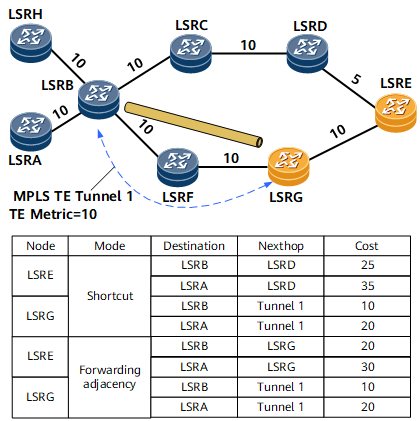Traffic Forwarding Component
An MPLS TE tunnel is established through information advertisement component, path calculation component, and path establishment component. Different from LDP LSPs, the LSPs established by MPLS TE cannot automatically import traffic to the tunnel for forwarding. Traffic needs to be imported to the MPLS TE tunnel using a certain mode, so that the device can forward traffic based on labels.
Static Route
The simplest way to divert traffic to a TE tunnel is to configure a static route. Such a static route works in the same way as common static routes. You only need to configure the TE tunnel interface as the outbound interface of the static route.
Auto Route
Auto route: A TE tunnel is considered as a logical link participating in IGP route calculation. The tunnel interface is used as an outbound interface in the auto route. The TE tunnel is considered a P2P link with a specified metric value. The following auto routes are supported:
IGP shortcut: A route related to a CR-LSP is not advertised to neighbor nodes, preventing other nodes from using the CR-LSP.
Forwarding adjacency: A route related to a CR-LSP is advertised to neighbor nodes, allowing these nodes to use the CR-LSP.
Forwarding adjacency allows tunnel information to be advertised based on IGP neighbor relationships.
If the forwarding adjacency is used, nodes on both ends of a CR-LSP must be in the same area.
The following example demonstrates the IGP shortcut and forwarding adjacency.
- The auto route is not used. LSRE uses LSRD as the next hop in a route to LSRA and a route to LSRB; LSRG uses LSRF as the next hop in a route to LSRA and a route to LSRB.
- The auto route is used. Either IGP shortcut or forwarding adjacency can be configured:
The IGP shortcut is used to advertise the route of Tunnel 1. LSRE uses LSRD as the next hop in the route to LSRA and the route to LSRB; LSRG uses Tunnel 1 as the outbound interface in the route to LSRA and the route to LSRB. LSRG, unlike LSRE, uses Tunnel 1 in IGP path calculation.
The forwarding adjacency is used to advertise the route of Tunnel 1. LSRE uses LSRG as the next hop in the route to LSRA and the route to LSRB; LSRG uses Tunnel 1 as the outbound interface in the route to LSRA and the route to LSRB. Both LSRE and LSRG use Tunnel 1 in IGP path calculation.
Policy-based Routing
The policy-based routing (PBR) allows the system to select routes based on user-defined policies, improving security and load balancing traffic. On an MPLS network, PBR enables IP packets that meet filter criteria to be forwarded over specific LSPs.
MPLS TE PBR, the same as IP unicast PBR, is implemented based on a set of matching rules and behaviors. The rules and behaviors are defined using an apply clause, in which the outbound interface is a specific tunnel interface. If packets do not match PBR rules, they are properly forwarded using IP; if they match PBR rules, they are forwarded over specific CR-LSPs.
Tunnel Policy
- Select-seq mode: A TE tunnel is selected as a public tunnel for VPN traffic based on the prioritized tunnel types set in the tunnel policy.
- Tunnel binding mode: A TE tunnel is bound to a destination address in a tunnel policy. This policy applies only to TE tunnels.
